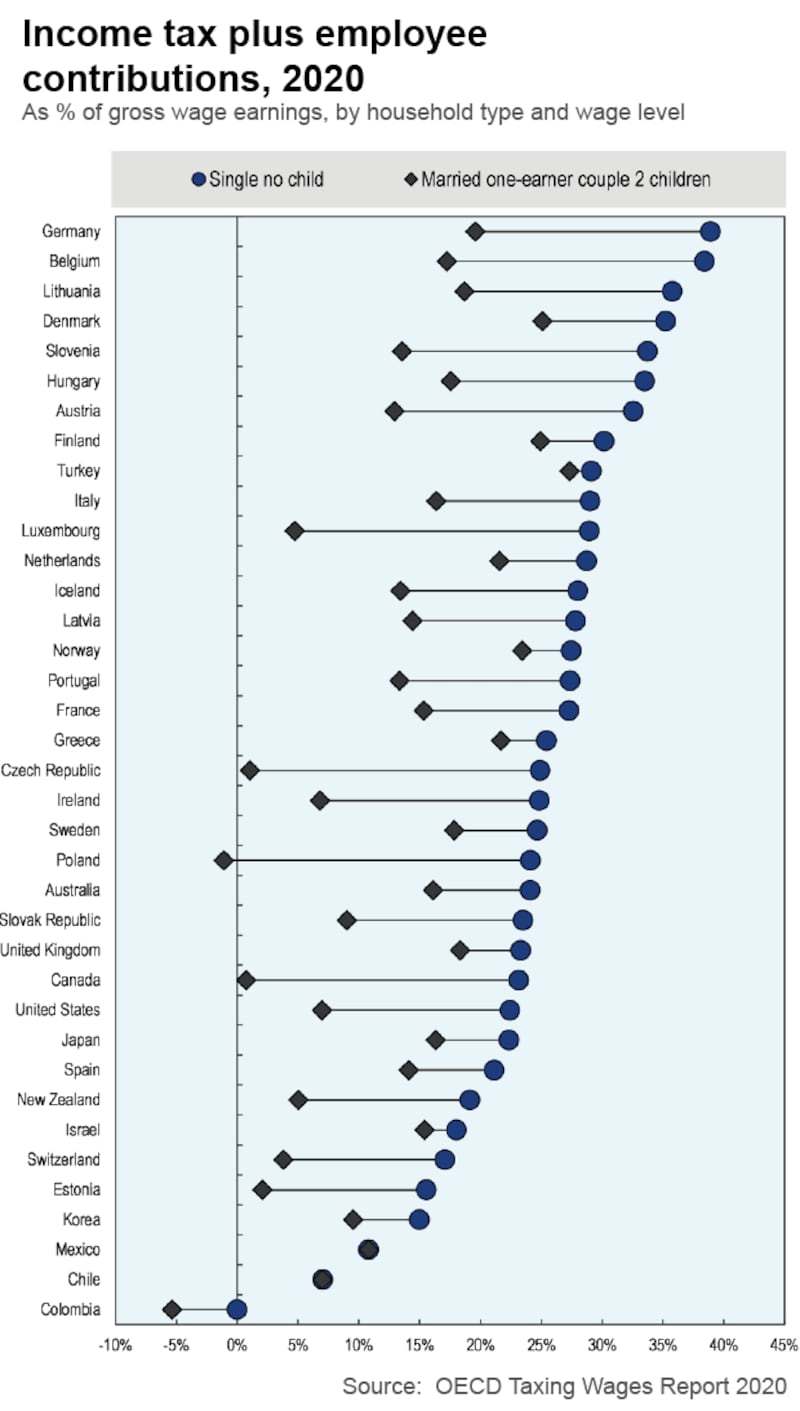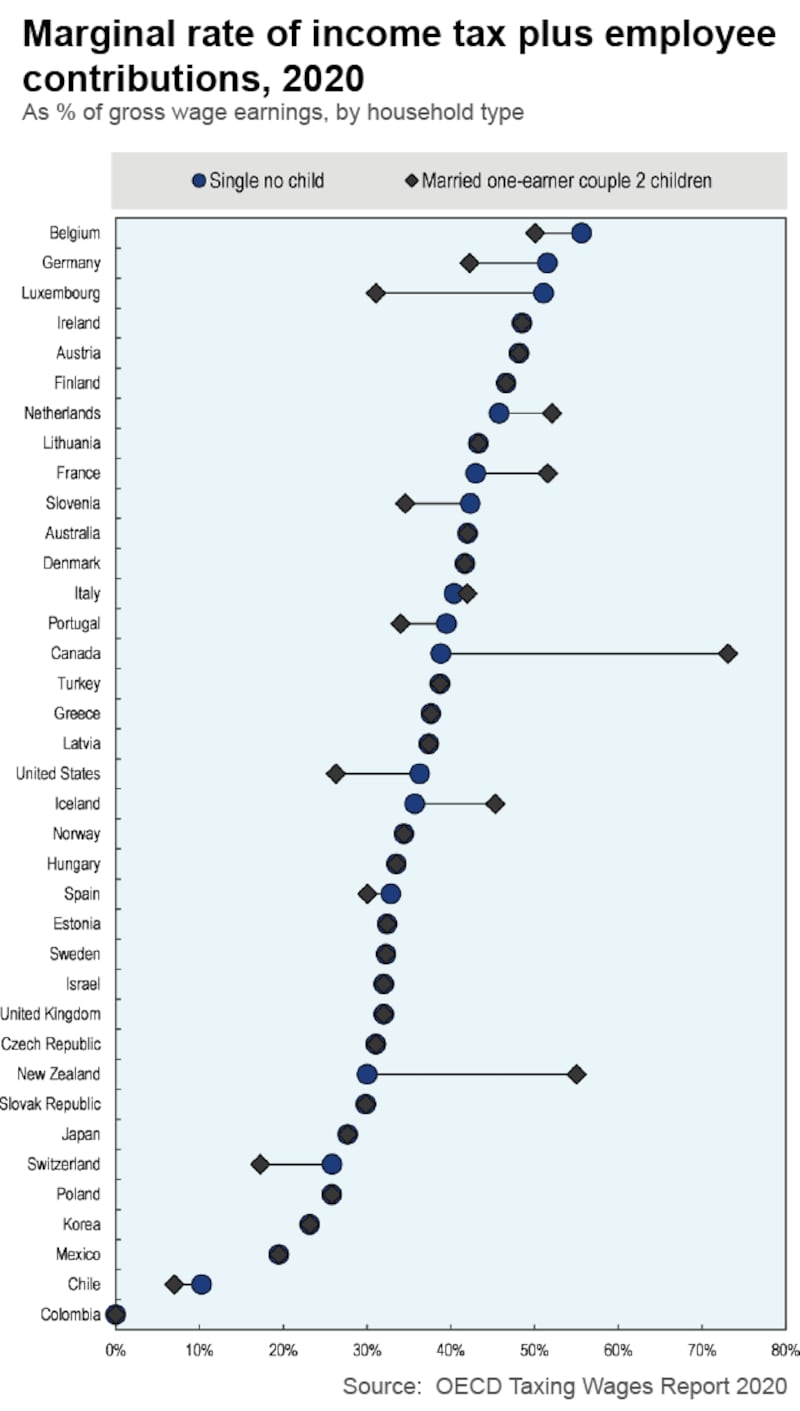In a comment on the decision by Facebook to allow some of its employees to work from overseas permanently, Tánaiste Leo Varadkar said the Republic's high tax rates will be a "major disincentive" when competing for remote workers. If employees working for companies based here locate themselves overseas permanently, then Ireland will lose the associated income tax revenues – and the spending here by these more highly paid employees. But are tax rates here really that high by international standards?
1. Irish income tax is about more than rates
Irish income tax rates are, indeed, high by international comparison. Most of the employees in the multinationals where remote working will be an option will face a marginal rate – the amount they pay on their next euro of income – of around 52 per cent. Those earning at higher levels – well over €100,000 – will face income tax bills at the higher end of the international average, especially if they are single. But tax rates are only part of the story in terms of how people pay tax.
Data has shown that the average Facebook employee is paid over €150,000 a year, though this average may be influenced by a relatively small number of very highly paid earners. On incomes of €150,000 or more, the impact of higher Irish income tax rates does push the tax bill here above the international averages.
A KPMG survey with the Irish Tax Institute in 2019 of eight countries showed that at a salary of €150,000, employees in Sweden and Germany paid more than in the Republic while those in France, the UK, the US, Switzerland and Singapore paid less. Some southern EU countries – notably Spain – would also typically have lower tax bills – so lower tax and sun could lead some to consider living there, if their Irish employer allows this.
2. Remote working - a significant trend?
It is not yet clear if remote working from another country is going to be a significant trend. There are legal and tax implications which will mean employers are cautious and recruitment and industry sources say that the trend in recent months has been for companies to call back employees to Ireland, rather than let them stay abroad. Legally employees overseas can accrue employee rights that apply in other countries, making personnel management very difficult. And as well as income tax considerations, there can be corporation tax complications if an employee is judged to have set up a “permanent establishment” for a company overseas and is dealing with customers.
Nonetheless the Facebook announcement has rattled nerves in Government circles – and remote working could well emerge as more common for some of the most highly skilled employees who will try to push employers to allow this.


3. The wider Irish tax system
Looking at international comparisons, the tax take in Ireland varies across income levels. The latest OECD data shows that all labour taxes – income tax, employer and employee PRSI and the USC – take on average 32.3 per cent of earnings in Ireland versus 34.6 per cent in the OECD average. The Republic is in 25th place out of 37 countries in the survey. So Ireland is a bit below the average.
The graphs show the key difference between marginal tax rates – the take on an extra euro of income – and the total or effective tax take on all income – the total percentage of your income that goes in tax. On marginal rates, Ireland is near the top of the international table. But in terms of the total take, the story is different.
A breakdown of the data shows that at lower earnings levels, income and social security taxes are particularly low in Ireland– taking 24 per cent for a single employee on two thirds of the average wage –or about €31,250– versus an OECD average of 30.6 per cent or an average of 37 per cent for European countries.
Married couples on around average earnings – the OECD uses a figure of just over €46,000 – also pay relatively low tax by international standards, again because of the way the system is set up.
The Irish tax system is highly progressive, with the take much higher on better-paid people. And it starts to rise on middle income people, with a single employee entering the higher 40 per cent income tax rate at €35,300 and a one-income married couple at €44,300. This starts to move the level of tax and PRSI in Ireland up the international tables as earnings start to rise. So, at earnings of €78,000, a single person is paying 41.2 per cent of their income in tax and PRSI, above the OECD average of 39 per cent, but below the EU figure of 45.8 per cent. The OECD does not produce comparisons for higher earners, but as we saw above, the State does gradually move up the chart as incomes increase,due largely to higher marginal rates kicking in at relatively modest income levels.

4. The social security questions
These comparisons are tricky, partly due to the impact of PRSI and the different entitlements which accrue in various countries. Irish people typically pay less in social security than most other countries. Comparing social security is complicated –for example payments in Germany are much higher than Ireland for most people, but entitlements in areas such as health are much greater. And if, for example, you could cut or eliminate your private insurance bill, then this would make a big difference to disposable income.Another point to note is that employers’ PRSI is relatively low in Ireland and looks set to rise at some stage over the next few years.
5. The policy issues
These kinds of factors help explain why many middle-income families feel financially squeezed in Ireland – along, of course, with the key factor, the high level of house prices and rental costs and the generally high cost of living here.
So while tax rates and the bills faced by higher earners will be a factor for employees in companies such as Facebook, there are a host of other issues too. Chief among these is housing and the fact that rentals here are among the most expensive in Europe – and only exceeded internationally by major cities such as London and New York.
Whether employees work remotely – or don’t – these will be vital issues in attracting further investment and jobs to Ireland. It remains to be seen how important the remote working trend will be, in terms of employees working across jurisdictions. But an environment that attracts skilled employees will be vital to attracting future investment to the country; taxes on income are part of the story, but there are many other issues in the mix as well.
The final point is that deciding where to set tax for different groups is never driven purely by international comparisons. As well as purely economic arguments relating to efficiency and economic impact, there is a large element of value judgement here on who should pay and how they should pay. ESRI research has shown that Ireland has tended to depend more on consumption taxes and less on taxes on labour and capital. Whether this will continue as demands on State spending rise is an interesting question.










